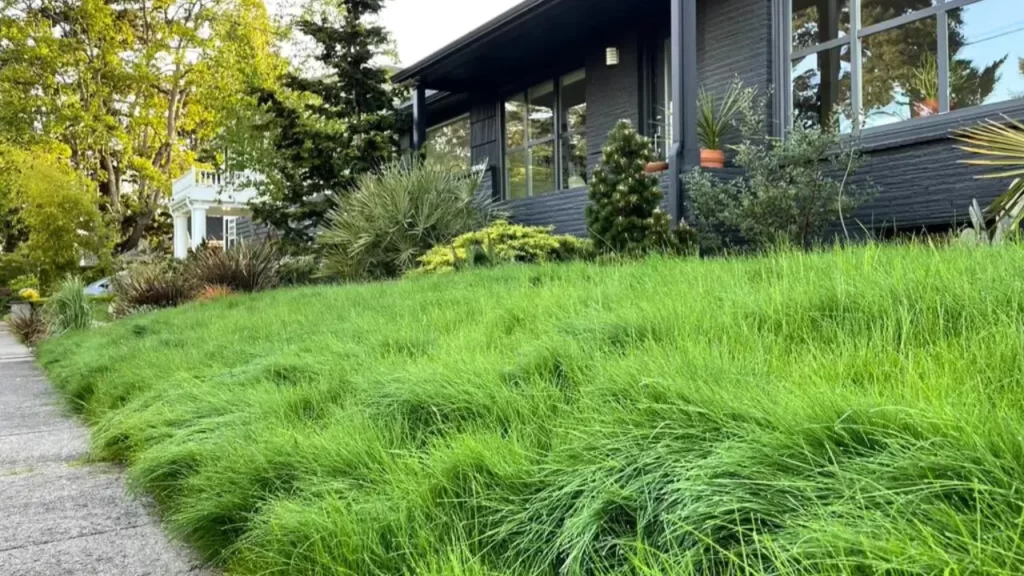Choosing the right type of grass for your lawn or landscape project is an essential process. It is important to choose the right characteristics and type of grass which is suitable for your lawn. So here in this article, we will explore the differences between Red Fescue vs Tall Fescue, which are the two most popular grass species used for residential and commercial applications.
So, in this article, we will understand their unique qualities, growth habits, maintenance needs, and suitability for various climates, so you can make an informed decision and select the best suitable grass for your lawn.

Quick Comparison Between Red Fescue vs Tall Fescue
| Points of Comparison | Red Fescue | Tall Fescue |
|---|---|---|
| 1. Climate Suitability | Performs well in cooler climates and shade conditions | Thrives in a wide range of climates, including both cool and warm regions |
| 2. Growth Habit | The clumping growth habit forms dense tufts | Bunch-type growth habit, with upright and broader leaf blades |
| 3. Maintenance Requirements | A slower growth rate requires less frequent mowing and maintenance | A faster growth rate may need more frequent mowing and maintenance |
| 4. Drought Tolerance | More drought-tolerant than tall fescue | Moderate drought tolerance |
| 5. Shade Tolerance | Excellent shade tolerance | Less shade-tolerant compared to red fescue |
| 6. Wear Tolerance | Moderate wear tolerance | Excellent wear tolerance, suitable for high-traffic areas |
| 7. Aesthetics | Fine texture, soft and luxurious appearance | Broader leaf blades provide a robust and rugged look |
| 8. Soil Adaptability | Broader leaf blades provides a robust and rugged look | Adaptable to different soil types, including sandy and clay soils |
| 9. Heat Tolerance | Lower tolerance to high-temperature conditions, may go dormant in extreme heat | More heat-tolerant compared to red fescue |
| 10. Common Usage | Ideal for shaded areas and low-maintenance lawns | Suitable for high-traffic areas, sports fields, and play areas |
Also Read: How To dethatch bermuda grass from Different methods
Best Red Fescue Grass Seed
Best Tall Fescue Grass Seed
What is Red Fescue?
Red fescue (Festuca rubra) is a cool-season grass that belongs to the Poaceae family. This grass is known for its texture which gives the lawn a luxurious and soft appearance. The Red fescue is originally native to Europe but it has become popular in North America due to its ability to withstand different climate conditions.

Characteristics of Red Fescue
Here are some of the characteristics of red fescue which make it a desirable choice for many lawns in different conditions.
- The Red fescue normally has a narrow leaf blade with a deep green color, although variations with blue-green hues are also available.
- This grass species has a clumping growth habit and forms dense tufts, creating a visually appealing carpet-like effect in lawns.
- The Red fescue is also known for its shade tolerance, which allows it to grow in an area with shade or filtered sunlight.
- Due to their shade tolerance ability, these grasses are best for the yard with trees and buildings that cast a shadow.
- Red fescue can able to grow in limited water also which makes it perfect for the place with dry seasons.
Advantages of Red Fescue
The Red Fescue has many advantages which make it one of the best grasses that most homeowners chose for their lawn.
- Its shade tolerance ability make this grass best for places where limited sunlight can reach and where other grasses do not survive this red fescue can survive in a shaded area.
- Red fescue has a slow growth rate so it needs less maintenance and needs less mowing compared to other garden grasses with fast growth.
- Red fescue can grow in different soil conditions like sandy, loamy, and clay soils.
- Red fescue can tolerate acidic soil conditions also.
- Red fescue has moderate tolerance to salt, making it suitable for coastal regions.
All of these qualities make the red fescue best for different conditions, weather, soil, and areas.
Also Read: Chewing Fescue vs Creeping Red Fescue a quick comparison
Limitations of Red Fescue
As with its advantages, there are some limitations of this red fescue grass which makes it not difficult to survive or grow in certain conditions.
- Red fescue can’t tolerate high-temperature climates, so it’s hard to grow red fescue in high-temperature climates(it is suitable for cooler climates)
- If the red fescue is exposed to high temperatures it can turn brown or scorched due to heat stress.
- Red fescues are not have good wear tolerance so it is not the best choice for lawns subjected to heavy foot traffic. (But the wear tolerance can be improved by growing with other grasses)
These are some of the limitations which make red fescue grass not suitable for certain conditions or climates.
What is Tall Fescue?
Tall fescue (Festuca arundinacea) is another cool-season grass that has gained popularity for its adaptability and durability. The Tall fescue is a bunch-type of grasses that has a more upright growth habit. Where the Red Fescue is bunching grass.
The Tall Fescue are also Europe native grasses and these grasses are widely used for lawns, sports fields, and pastures.

Characteristics of Tall Fescue
Here are some of the characteristics of the Tall Fescue.
- Tall Fescue has broader leaf blades compared to red fescue and its color ranges from dark green to medium green.
- Tall Fescue forms dense clumps with deep roots system which allows these grasses to tolerate and withstand dry seasons.
- Unlike the Red fescue, the Tall fescues are excellent wear tolerances so they can be used in high-traffic areas.
- Tall fescue can also adapt to different soil conditions like sandy and clay soils, etc.
- It can grow well in both acidic and alkaline soil conditions.
- The long roots of the Tall fescue enable it to get water and nutrients from deeper soil layers.
Also Read: Kentucky Bluegrass vs Fescue vs Ryegrass which is best for lawn
Advantages of Tall Fescue
The Tall fescue has many advantages which make it suitable for many lawns so this grass is also chosen by many homeowners.
- The excellent wear tolerance ability of the Tall Fescue gras makes it suitable for high-traffic areas and houses with children and dogs who like to play on lawns.
- Tall fescue grows best in the area with ample sunlight.
- The long roots of the Tall Fescue enable it to survive in the dry season also with minimal water.
- The Tall fescue can tolerate different weather conditions like both hot and cold climates.
- Tall fescue is good resistance to common turf diseases, such as brown patch and dollar spot which reduces the excessive pesticide use
Limitations of Tall Fescue
Although tall fescue has numerous advantages, it is not without limitations.
- Tall fescue has lower shade tolerance compared to the Red fescue grass.
- If the Tall fescue is planted in heavily shaded are it can struggle to grow properly.
- Tall fescue has a faster growth rate compared to red fescue so it needs more maintenance and mowing compared to red fescue.
- Also, the clumping growth habit can lead to an uneven appearance if not managed properly.
Frequently Asked Question(FAQs)
Can red fescue and tall fescue be mixed together in a lawn?
Yes, red fescue and tall fescue can be mixed together in a lawn. This combination can provide a diverse and visually appealing lawn, combining the shade tolerance of red fescue with the wear tolerance of tall fescue.
Which grass is more drought-tolerant, red fescue, or tall fescue?
Red fescue exhibits better drought tolerance compared to tall fescue. Its deep root system and ability to access moisture from deeper soil layers contribute to its resilience during dry periods.
Is red fescue suitable for shady areas?
Yes, red fescue is well-suited for shady areas. It has excellent shade tolerance and can thrive in areas with filtered sunlight or partial shade.
How often should I mow red fescue and tall fescue?
Red fescue, with its slower growth rate, requires less frequent mowing compared to tall fescue. Generally, mowing every 10-14 days is sufficient for red fescue, while tall fescue may require mowing every 7-10 days.
Can red fescue and tall fescue withstand heavy foot traffic?
The Red fescue cannot withstand heavy foot traffic but the tall fescue can withstand heavy foot traffic.
Also Read: Best Small Garden irrigation systems for healthy plant growth
Conclusion
Both Red fescue and Tall fescue have their own advantages and disadvantages so it’s your choice to choose the perfect grass which is suitable for your lawn, soil, and climate conditions. Make sure to check all the points which we mentioned above to choose the suitable grass for your lawn.
